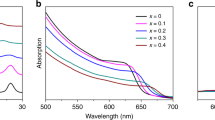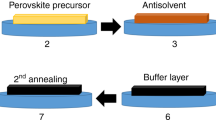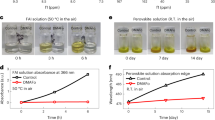Abstract
Cations with suitable sizes to occupy an interstitial site of perovskite crystals have been widely used to inhibit ion migration and promote the performance and stability of perovskite optoelectronics. However, such interstitial doping inevitably leads to lattice microstrain that impairs the long-range ordering and stability of the crystals, causing a sacrificial trade-off. Here, we unravel the evident influence of the valence states of the interstitial cations on their efficacy to suppress the ion migration. Incorporation of a trivalent neodymium cation (Nd3+) effectively mitigates the ion migration in the perovskite lattice with a reduced dosage (0.08%) compared to a widely used monovalent cation dopant (Na+, 0.45%). The photovoltaic performances and operational stability of the prototypical perovskite solar cells are enhanced with a trace amount of Nd3+ doping while minimizing the sacrificial trade-off.
This is a preview of subscription content, access via your institution
Access options
Access Nature and 54 other Nature Portfolio journals
Get Nature+, our best-value online-access subscription
$29.99 / 30 days
cancel any time
Subscribe to this journal
Receive 12 print issues and online access
$259.00 per year
only $21.58 per issue
Buy this article
- Purchase on Springer Link
- Instant access to full article PDF
Prices may be subject to local taxes which are calculated during checkout




Similar content being viewed by others

Data availability
The data that support the findings of this study are available from the corresponding authors upon request.
References
Kim, G., Min, H., Lee, K. S., Yoon, S. M. & Seok, S. I. Impact of strain relaxation on performance of α-formamidinium lead iodide perovskite solar cells. Science 370, 108–112 (2020).
Jeong, M. et al. Stable perovskite solar cells with efficiency exceeding 24.8% and 0.3-V voltage loss. Science 369, 1615–1620 (2020).
Zheng, X. et al. Managing grains and interfaces via ligand anchoring enables 22.3%-efficiency inverted perovskite solar cells. Nat. Energy 5, 131–140 (2020).
Lin, Y.-H. et al. A piperidinium salt stabilizes efficient metal-halide perovskite solar cells. Science 369, 96–102 (2020).
Liu, Z. et al. A holistic approach to interface stabilization for efficient perovskite solar modules with over 2,000-hour operational stability. Nat. Energy 5, 596–604 (2020).
Tan, H. et al. Efficient and stable solution-processed planar perovskite solar cells via contact passivation. Science 355, 722–726 (2017).
Jung, E. H. et al. Efficient, stable and scalable perovskite solar cells using poly(3-hexylthiophene). Nature 567, 511–515 (2019).
Wang, L. et al. A Eu3+-Eu2+ ion redox shuttle imparts operational durability to Pb-I perovskite solar cells. Science 363, 265–270 (2019).
Yuan, Y. & Huang, J. Ion migration in organometal trihalide perovskite and its impact on photovoltaic efficiency and stability. Acc. Chem. Res. 49, 286–293 (2016).
Calado, P. et al. Evidence for ion migration in hybrid perovskite solar cells with minimal hysteresis. Nat. Commun. 7, 13831 (2016).
Tan, S. et al. Steric impediment of ion migration contributes to improved operational stability of perovskite solar cells. Adv. Mater. 32, 1906995 (2020).
Lee, J.-W., Kim, S.-G., Yang, J.-M., Yang, Y. & Park, N.-G. Verification and mitigation of ion migration in perovskite solar cells. APL Mater. 7, 041111 (2019).
Zhang, H. et al. Phase segregation due to ion migration in all-inorganic mixed-halide perovskite nanocrystals. Nat. Commun. 10, 1088 (2019).
Boyd, C. C., Cheacharoen, R., Leijtens, T. & McGehee, M. D. Understanding degradation mechanisms and improving stability of perovskite photovoltaics. Chem. Rev. 119, 3418–3451 (2018).
Abdi-Jalebi, M. et al. Maximizing and stabilizing luminescence from halide perovskites with potassium passivation. Nature 555, 497–501 (2018).
Son, D.-Y. et al. Universal approach toward hysteresis-free perovskite solar cell via defect engineering. J. Am. Chem. Soc. 140, 1358–1364 (2018).
Cao, J., Tao, S. X., Bobbert, P. A., Wong, C. P. & Zhao, N. Interstitial occupancy by extrinsic alkali cations in perovskites and its impact on ion migration. Adv. Mater. 30, 1707350 (2018).
Jones, T. W. et al. Lattice strain causes non-radiative losses in halide perovskites. Energy Environ. Sci. 12, 596–606 (2019).
Zhao, J. et al. Strained hybrid perovskite thin films and their impact on the intrinsic stability of perovskite solar cells. Sci. Adv. 3, eaao5616 (2017).
Kim, J. Y., Lee, J.-W., Jung, H. S., Shin, H. & Park, N.-G. High-efficiency perovskite solar cells. Chem. Rev. 120, 7867–7918 (2020).
Lee, J.-W., Tan, S., Seok, S. I., Yang, Y. & Park, N.-G. Rethinking the A cation in halide perovskites. Science 375, eabj1186 (2022).
Callister, W. D. & Rethwisch, D. G. Fundamentals of Materials Science and Engineering. Vol. 471660817 (Wiley London, 2000).
Goldschmidt, V. Crystal structure and chemical constitution. Trans. Faraday Soc. 25, 253–283 (1929).
Fang, Z., He, H., Gan, L., Li, J. & Ye, Z. Understanding the role of lithium doping in reducing nonradiative loss in lead halide perovskites. Adv. Sci. 5, 1800736 (2018).
Li, C. et al. Emerging alkali metal ion (Li+, Na+, K+ and Rb+) doped perovskite films for efficient solar cells: recent advances and prospects. J. Mater. Chem. A 7, 24150–24163 (2019).
Zhao, P. et al. Improved carriers injection capacity in perovskite solar cells by introducing A-site interstitial defects. J. Mater. Chem. A 5, 7905–7911 (2017).
Yan, M., Cannon, R. & Bowen, H. Space charge, elastic field, and dipole contributions to equilibrium solute segregation at interfaces. J. Appl. Phys. 54, 764–778 (1983).
Kirchartz, T., Márquez, J. A., Stolterfoht, M. & Unold, T. Photoluminescence‐based characterization of halide perovskites for photovoltaics. Adv. Energy Mater. 10, 1904134 (2020).
Péan, E. V., Dimitrov, S., De Castro, C. S. & Davies, M. L. Interpreting time-resolved photoluminescence of perovskite materials. Phys. Chem. Chem. Phys. 22, 28345–28358 (2020).
Tan, S. et al. Shallow iodine defects accelerate the degradation of α-phase formamidinium perovskite. Joule 4, 2426–2442 (2020).
Kim, S.-G. et al. Potassium ions as a kinetic controller in ionic double layers for hysteresis-free perovskite solar cells. J. Mater. Chem. A 7, 18807–18815 (2019).
Domanski, K., Alharbi, E. A., Hagfeldt, A., Grätzel, M. & Tress, W. Systematic investigation of the impact of operation conditions on the degradation behaviour of perovskite solar cells. Nat. Energy 3, 61–67 (2018).
Cacovich, S. et al. Gold and iodine diffusion in large area perovskite solar cells under illumination. Nanoscale 9, 4700–4706 (2017).
Wu, S. et al. A chemically inert bismuth interlayer enhances long-term stability of inverted perovskite solar cells. Nat. Commun. 10, 1161 (2019).
Jiang, Q. et al. Surface passivation of perovskite film for efficient solar cells. Nat. Photon. 13, 460–466 (2019).
Jiang, Q. et al. Planar‐structure perovskite solar cells with efficiency beyond 21%. Adv. Mater. 29, 1703852 (2017).
Kresse, G. & Furthmüller, J. Efficient iterative schemes for ab initio total-energy calculations using a plane-wave basis set. Phys. Rev. B 54, 11169–11186 (1996).
Kresse, G. & Furthmüller, J. Efficiency of ab-initio total energy calculations for metals and semiconductors using a plane-wave basis set. Comput. Mater. Sci. 6, 15–50 (1996).
Perdew, J. P., Burke, K. & Ernzerhof, M. Generalized gradient approximation made simple. Phys. Rev. Lett. 77, 3865–3868 (1996).
Perdew, J. P. et al. Restoring the density-gradient expansion for exchange in solids and surfaces. Phys. Rev. Lett. 100, 136406 (2008).
Grimme, S. Semiempirical GGA‐type density functional constructed with a long‐range dispersion correction. J. Comput. Chem. 27, 1787–1799 (2006).
Grimme, S., Antony, J., Ehrlich, S. & Krieg, H. A consistent and accurate ab initio parametrization of density functional dispersion correction (DFT-D) for the 94 elements H-Pu. J. Chem. Phys. 132, 154104 (2010).
Blöchl, P. E. Projector augmented-wave method. Phys. Rev. B 50, 17953–17979 (1994).
Acknowledgements
This material is based upon work supported by the US Department of Energy’s Office of Energy Efficiency and Renewable Energy under the Solar Energy Technologies Office award no. DE-EE0008751. J.-W.L. and N.-G.P. acknowledge financial support from a National Research Foundation of Korea grant funded by the Korea government (Ministry of Science and ICT) under contract nos 2022R1C1C1011975, 2022M3J1A1064315 and 2021R1A3B1076723 (Research Leader Program). M.W. and J.B. acknowledge financial support from the National Natural Science Foundation of China (nos 12104081 and 51872036). Computing resources used in this work were provided by the National Center for High Performance Computing of Turkey (grant no. 1008342020). I.Y. acknowledges support by the Scientific and Technological Research Council of Turkey (TÜBITAK; grant no. 119F380). We thank Y. Chen and X. Li from the Instrumentation and Service Center for Molecular Sciences at Westlake University for the assistance with measurements.
Author information
Authors and Affiliations
Contributions
Y. Zhao and J.-W.L. conceived the idea, designed and conducted the experiments and prepared the manuscript under the supervision of Y. Yang. I.Y. performed the DFT calculations. M.W. collected the SEM data under the supervision of J.B.; M.H.W. performed the positron annihilation spectroscopy test and analysed the data. M.X. helped take the cryogenic cross-sectional transmission electron microscopy images under the supervision of X.P.; J.-H.L. and S.-G.C. conducted the in situ PL and TOF-SIMS measurements. S.T. helped with the X-ray diffraction tests. T.H. performed the transient photovoltage tests. S.-J.L. measured the d.c. temperature-dependent conductivity of the samples. A.Z. helped with film optimization. Y. Yin and J.L. performed the PL and absorption measurements under the supervision of Y.S. and H.M.; W.Y., Q.X., Y. Zhou and E.Z. helped with data analysis. P.S. and S.W. helped with the ICP-MS measurements. R.W., J.X., T.-H.H., S.-H.B. and N.-G.P. provided helpful discussion during the project. All the authors discussed the results and commented on the manuscript.
Corresponding authors
Ethics declarations
Competing interests
The authors declare no competing interests.
Peer review
Peer review information
Nature Materials thanks Samuel Stranks and the other, anonymous, reviewer(s) for their contribution to the peer review of this work.
Additional information
Publisher’s note Springer Nature remains neutral with regard to jurisdictional claims in published maps and institutional affiliations.
Supplementary information
Supplementary Information
Supplementary Notes 1–3, Figs. 1–28 and Tables 1–10.
Supplementary Video 1
In situ PL measurement using lateral devices based on the reference film and the film incorporated with 0.08% Nd3+. The measurements were made under 440 nm illumination and an electric field of 150 mV μm–1 to visualize the ion migration.
Rights and permissions
Springer Nature or its licensor (e.g. a society or other partner) holds exclusive rights to this article under a publishing agreement with the author(s) or other rightsholder(s); author self-archiving of the accepted manuscript version of this article is solely governed by the terms of such publishing agreement and applicable law.
About this article
Cite this article
Zhao, Y., Yavuz, I., Wang, M. et al. Suppressing ion migration in metal halide perovskite via interstitial doping with a trace amount of multivalent cations. Nat. Mater. 21, 1396–1402 (2022). https://doi.org/10.1038/s41563-022-01390-3
Received:
Accepted:
Published:
Issue Date:
DOI: https://doi.org/10.1038/s41563-022-01390-3
This article is cited by
-
Highly stabilized and efficient thermoelectric copper selenide
Nature Materials (2024)
-
Toward stabilization of formamidinium lead iodide perovskites by defect control and composition engineering
Nature Communications (2024)
-
Suppression of phase segregation in wide-bandgap perovskites with thiocyanate ions for perovskite/organic tandems with 25.06% efficiency
Nature Energy (2024)
-
Trends in defect passivation technologies for perovskite-based photosensor
Journal of the Korean Ceramic Society (2024)
-
Orientated crystallization of FA-based perovskite via hydrogen-bonded polymer network for efficient and stable solar cells
Nature Communications (2023)


